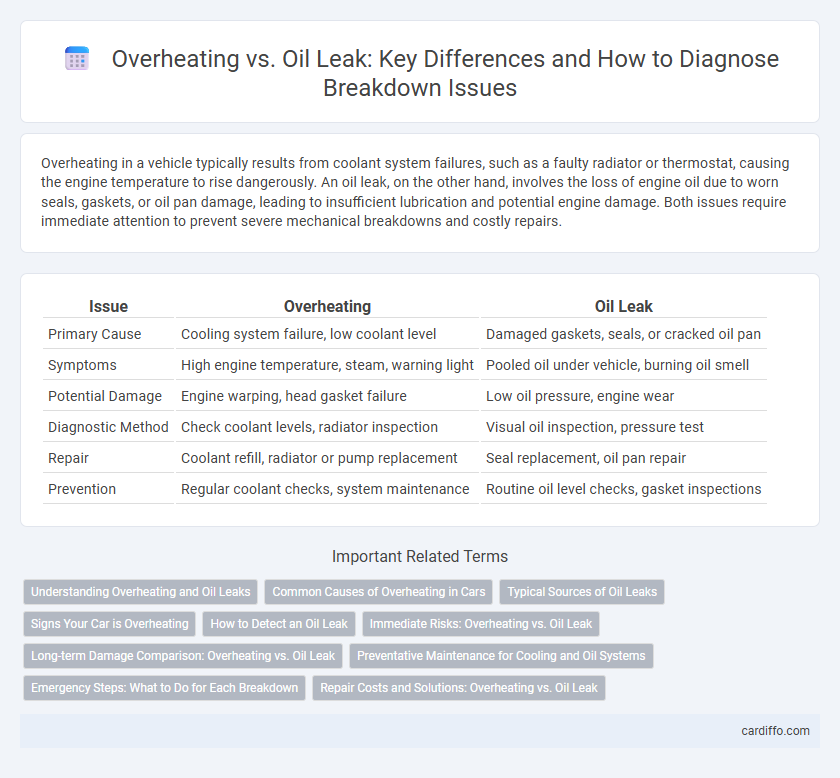Overheating in a vehicle typically results from coolant system failures, such as a faulty radiator or thermostat, causing the engine temperature to rise dangerously. An oil leak, on the other hand, involves the loss of engine oil due to worn seals, gaskets, or oil pan damage, leading to insufficient lubrication and potential engine damage. Both issues require immediate attention to prevent severe mechanical breakdowns and costly repairs.
Table of Comparison
| Issue | Overheating | Oil Leak |
|---|---|---|
| Primary Cause | Cooling system failure, low coolant level | Damaged gaskets, seals, or cracked oil pan |
| Symptoms | High engine temperature, steam, warning light | Pooled oil under vehicle, burning oil smell |
| Potential Damage | Engine warping, head gasket failure | Low oil pressure, engine wear |
| Diagnostic Method | Check coolant levels, radiator inspection | Visual oil inspection, pressure test |
| Repair | Coolant refill, radiator or pump replacement | Seal replacement, oil pan repair |
| Prevention | Regular coolant checks, system maintenance | Routine oil level checks, gasket inspections |
Understanding Overheating and Oil Leaks
Overheating occurs when the engine's cooling system fails to regulate temperature, causing the engine to run hotter than normal, which can lead to severe damage. Oil leaks are typically caused by worn gaskets, seals, or damaged oil pans, resulting in loss of lubrication that can further harm engine components. Understanding the differences in symptoms, such as high temperature gauge readings for overheating versus visible oil spots or smoke for leaks, is crucial for timely diagnosis and repair.
Common Causes of Overheating in Cars
Overheating in cars commonly results from coolant system failures, such as low coolant levels, radiator blockages, or a malfunctioning thermostat. Engine oil leaks, while critical, usually lead to lubrication issues rather than direct overheating but can exacerbate heat buildup by increasing engine friction. Regular maintenance of cooling system components and timely oil leak repairs are essential to prevent engine overheating and breakdowns.
Typical Sources of Oil Leaks
Typical sources of oil leaks in vehicle breakdowns include worn-out gaskets, damaged oil seals, and loose or cracked oil pans. Overheating can exacerbate these issues by causing metal components to expand and degrade seals faster, increasing the likelihood of leaks. Identifying the specific source is crucial for effective repair and preventing further engine damage.
Signs Your Car is Overheating
Signs your car is overheating include a rising temperature gauge, steam or smoke emanating from the engine, and a burning smell inside or outside the vehicle. Loss of engine power, frequent stalling, and coolant warning lights also indicate potential overheating issues. Monitoring these symptoms early can prevent severe engine damage and costly repairs.
How to Detect an Oil Leak
Detecting an oil leak involves inspecting the engine and surrounding areas for dark, greasy spots or puddles under the vehicle. Use a flashlight to examine hoses, gaskets, and the oil pan for wet or shiny areas indicating fresh oil. Monitoring oil levels regularly and watching for a burning smell or smoke can also help identify leaks before overheating occurs.
Immediate Risks: Overheating vs. Oil Leak
Overheating causes engine components to expand and fail rapidly, risking complete engine seizure and costly repairs. An oil leak reduces lubrication, leading to increased friction, overheating, and potential engine damage if not promptly addressed. Both issues demand immediate attention to avoid severe mechanical failure and ensure vehicle safety.
Long-term Damage Comparison: Overheating vs. Oil Leak
Overheating causes extensive engine damage by warping cylinder heads and compromising gasket integrity, leading to costly repairs beyond initial cooling system fixes. Oil leaks result in insufficient lubrication, accelerating internal component wear and potentially causing engine seizure if left unaddressed. Long-term damage from overheating often requires engine rebuilding, while prolonged oil leaks degrade engine performance and longevity, highlighting the critical need for timely diagnosis and repair.
Preventative Maintenance for Cooling and Oil Systems
Regular inspection and maintenance of the cooling system, including radiator flushes and coolant replacement, prevent overheating by ensuring efficient heat dissipation. Monitoring oil levels and replacing oil and filters on schedule reduce the risk of oil leaks caused by degraded seals or sludge buildup. Implementing a routine preventative maintenance plan for both cooling and oil systems enhances engine reliability and extends vehicle lifespan.
Emergency Steps: What to Do for Each Breakdown
During an overheating breakdown, immediately turn off the engine and allow the vehicle to cool for at least 30 minutes before inspecting the coolant level or radiator for leaks. If an oil leak is suspected, check for low oil levels and avoid driving to prevent engine damage, then call for roadside assistance to safely address the leak. Taking prompt, specific emergency steps for overheating or oil leaks prevents further mechanical damage and ensures driver safety.
Repair Costs and Solutions: Overheating vs. Oil Leak
Repair costs for overheating issues typically involve thermostat replacement, radiator repairs, or water pump servicing, ranging from $300 to $1,200 depending on severity. Oil leak repairs vary widely, from minor gasket replacements costing around $150 to major engine seal repairs exceeding $1,000. Addressing overheating often requires coolant system diagnostics and flushes, while oil leaks demand inspection of seals, gaskets, and potential engine component replacements to prevent further damage.
Overheating vs oil leak Infographic

 cardiffo.com
cardiffo.com